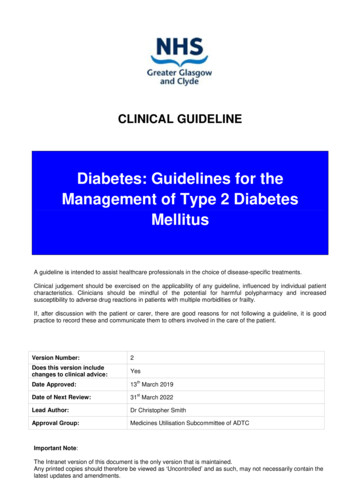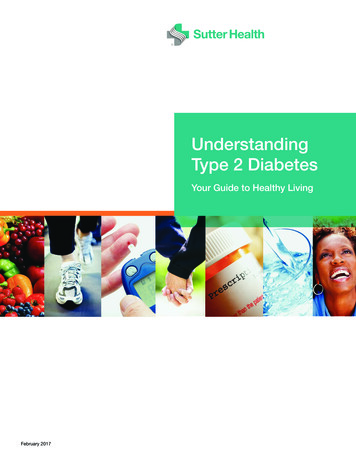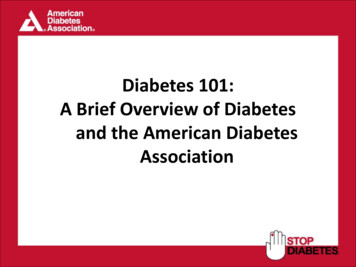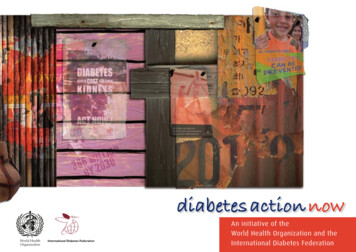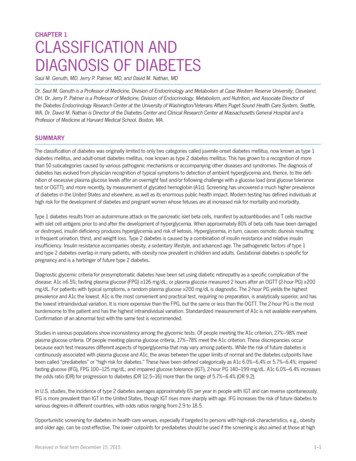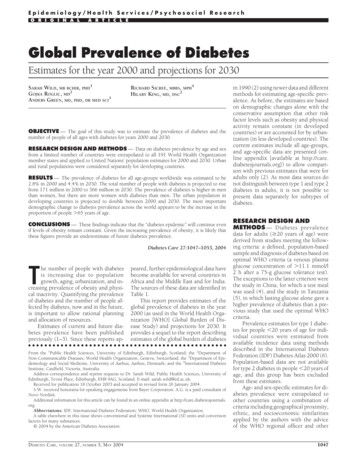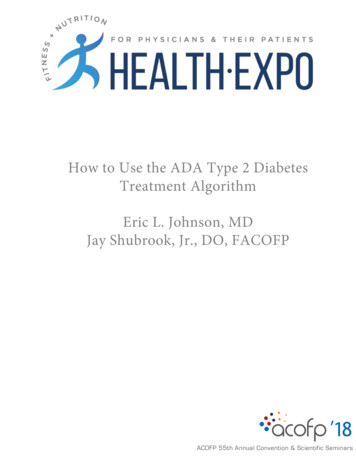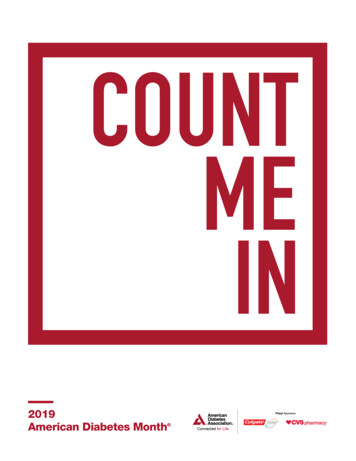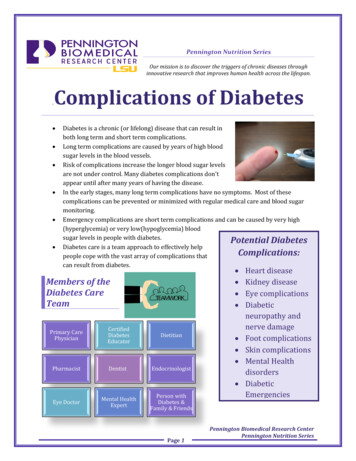
Transcription
Pennington Nutrition SeriesOur mission is to discover the triggers of chronic diseases throughinnovative research that improves human health across the lifespan.Complications of Diabetes. Diabetes is a chronic (or lifelong) disease that can result inboth long term and short term complications.Long term complications are caused by years of high bloodsugar levels in the blood vessels.Risk of complications increase the longer blood sugar levelsare not under control. Many diabetes complications don'tappear until after many years of having the disease.In the early stages, many long term complications have no symptoms. Most of thesecomplications can be prevented or minimized with regular medical care and blood sugarmonitoring.Emergency complications are short term complications and can be caused by very high(hyperglycemia) or very low(hypoglycemia) bloodsugar levels in people with diabetes.Potential DiabetesDiabetes care is a team approach to effectively helpComplications:people cope with the vast array of complications thatcan result from diabetes. Members of theDiabetes CareTeamPrimary rmacistDentistEndocrinologistEye DoctorMental HealthExpertPerson withDiabetes &Family & FriendsPage 1 Heart diseaseKidney diseaseEye complicationsDiabeticneuropathy andnerve damageFoot complicationsSkin complicationsMental HealthdisordersDiabeticEmergenciesPennington Biomedical Research CenterPennington Nutrition Series
Diabetes and Heart DiseaseHeart and blood vessel disease are the most common long-term complications of diabetes.Coronary artery disease is caused by a narrowing or blocking of the blood vessels to theheart. It is the most common form of heart disease. The blood vessels to the heart areimportant because the blood flowing through them carries oxygen and other necessarymaterials. Unfortunately, these blood vessels can become partially or totally blocked byfatty deposits. A heart attack occurs when the blood supply to the heart is reduced or cutoff.People with diabetes have a higher risk for some cardiovascular diseases, including: Heart attack (caused by a blockage of the blood vessels supplying blood tothe heart)Stroke (caused by a blockage of the blood vessels supplying the brain)Blocked blood vessels in the legs and feet, which can lead to foot ulcers,infections, and even loss of a toe, foot, or lower legWhether a person has diabetes or not, the risk for these problems increase due to: SmokingObesityAbnormal levels of blood lipids (triglycerides or cholesterol)High blood pressureFamily history of heart attack or stroke before age 50How to reduce Risk of Complications:Knowing your ABCs“A” is for A1CA1C is the blood glucose check “with amemory.” It determines average bloodglucose control over the past 2 to 3months.“B” is for bloodpressureBlood pressure (BP) numbers are theforce of blood inside the blood vessels.With a high blood pressure, this meansthat the heart is having to workharder than it should.Cholesterol numbers are the amount offat in the blood. Goodcholesterol(HDL), help protect theheart. Bad cholesterol(LDL), can clogthe blood vessels, leading to heartdisease.“C” is for cholesterolPage 2The American DiabetesAssociation (ADA)recommends an A1C below 7.However, goals may be differentfor each individual.The ADA recommends a BP below130/80.Total Cholesterol 200mg/dLLDL 100mg/dLHDL for men 40mg/dL or higherHDL for women 50mg/dL orhigherPennington Biomedical Research CenterPennington Nutrition Series
Diabetes & Kidney Disease Kidney disease or kidney damage often occurs over time in people withdiabetes. This type of kidney disease is called diabetic nephropathy.The kidneys’ main job is to filter waste and extra water out of the blood to makeurine.High levels of blood sugar can damage the blood vessels in the kidneys. Whenthe blood vessels are damaged, they are not able to filter waste out of the blood.Many people with diabetes also develop high blood pressure, which can alsodamage your kidneys.There are 5 stages of kidney disease. When kidney disease is caught early, thereare treatments available to keep the kidney disease from getting worse.Unfortunately, when kidney disease is diagnosed later, the stress from years ofoverworking the kidneys causes the kidneys to lose their filtering ability. This iscalled end-stage renal disease (ESRD) and treatment usually includes either akidney transplant or dialysis.Symptoms:Risk Factors for Kidney Disease: Kidney disease produces little to nosymptoms until almost all function isgone. The first symptom of kidneydisease is usually fluid buildup. Othersymptoms of kidney disease includeloss of sleep, poor appetite, upsetstomach, weakness, and difficultyconcentrating. Testing is usually theonly way to know if there is kidneydisease.High blood sugar levelsHigh blood pressureSmokingPoor nutritionHigh salt dietInactivityOverweightFamily historyHeart diseaseWays to Reduce the Risk: Control blood sugar and blood pressureTake medications as prescribedQuit smokingWork with dietitian on meal planGet enough sleepMaintain/get to healthy weightPage 3People with diabetes should be testedevery year if: Have been diagnosed with type2 diabetesHave been diagnosed with type1 diabetes for more than 5yearsPennington Biomedical Research CenterPennington Nutrition Series
Diabetes & Eye ComplicationsEyes can become damaged if blood sugar levels remain high over a period of time. This can causedamage to the blood vessels in the back of the eyes. This leads to poorvision or blindness.Diabetes is the primary cause of blindness in adults.Types of Diabetic Eye Complications:1. Blurry Vision High blood sugar and/or rapid changes in blood sugar levels can cause blurry vision.This is because the lens in the middle of the eye cannot change shape when it has toomuch sugar and water in the lens. This is not the same problem as diabetic retinopathy and usually corrects itself whenblood sugar levels normalize.2. Retinopathy Retinopathy is caused by damage to the blood vessels of the Retina (the layer of tissueat the back of the eye. It senses light and changes it into signals that are sent to thebrain). Retinopathy occurs when tiny blood vessels leak blood and other fluids. Thiscauses the retinal tissue to swell, which results in cloudy or blurred vision. The longer a person has diabetes, the higher the risk for developing diabeticretinopathy. If left untreated, diabetic retinopathy can cause blindness. There are two major types of retinopathy: nonproliferative and proliferative.1.Nonproliferative is the early stage and there are usually no or mild symptoms.2.Proliferative is the more advanced stage where the retina is deprived ofoxygen and new, fragile blood vessels can begin to grow in the retina. The newblood vessels may leak blood thus clouding vision. Another concern withproliferative retinopathy is retinal detachment.3. Cataracts Cataracts are clouding of the eye’s lens. Adults with diabetes are 2-5 times more likely than those without diabetes to developcataracts and the disease also tends to develop earlier in people with diabetes.4. Glaucoma Glaucoma is a condition that damages the eye’s optic nerve (the bundle of nerve fibersthat connects the eye to the brain). Some types of glaucoma are associated with elevated pressure inside the eye. In adults, diabetes nearly doubles the risk of glaucoma.Page 4Pennington Biomedical Research CenterPennington Nutrition Series
5. Macular Edema Macular edema is swelling in an area of the retina called the macula (which isresponsible for our color vision and fine detail vision). This condition can destroy the sharp vision in this part of the eye, leading to partialvision loss or blindness. Macular edema usually develops in people who already haveother signs of diabetic retinopathy.Regular eye exams are crucial for detecting eye complications early when the problem can bemonitored and treated to keep vision.Eye exam guidelines for diabetes:Type 1 diabetes: Yearly eye exams should startwithin 5 years of diagnosis.Type 2 diabetes: Yearly eye exams should startright after diagnosis.Pregnancy: Women with type 1 and type 2diabetes need an eye exam before pregnancy orwithin the first 3 months. Your doctor may want youto repeat the exam later in your pregnancy anduntil your baby is 1 year old.Gestational Diabetes: Women who developgestational diabetes don’t usually need an eyeexam because they don’t develop diabetic eyedisease during pregnancy.Page 5Pennington Biomedical Research CenterPennington Nutrition Series
Diabetes and Nerve DamageNerve damage due to high blood sugars is called diabetic neuropathy. The damage to the nerves canaffect the ability of the nerve to send signals. These signals give information to the brain about painand temperature. The nerves in the legs and feet are the most frequently injured. This complicationof diabetes is common and can be very serious.Types of Diabetic Neuropathy1. Peripheral Neuropathy Peripheral Neuropathy is the most common type of neuropathy and it is caused bydamage to the nerves of the peripheral nervous system (feet, legs, hands, & arms).2. Autonomic Neuropathy Autonomic Neuropathy is caused by damage to the nerves of internal organs (heart,bladder, stomach, intestines, sex organs, and eyes).3. Focal Neuropathies Focal Neuropathies usually are caused damage to a single nerve (typically in the hands,head, torso, or leg).4. Proximal Neuropathy Proximal Neuropathy is nerve damage in the hip, buttock, or thigh. This type is rarebut can be disabling.Complications ofDiabetic Neuropathy Amputation of toe, foot or legDamage to jointUrinary tract infectionHypoglycemic unawarenessSlow digestion in stomach(gastroparesis)Diarrhea or constipationBlood pressure drops(dizziness when standing)Sexual dysfunctionIncreased/decreased sweatingChanges in visionPage 6Pennington Biomedical Research CenterPennington Nutrition Series
Diabetes and Foot ComplicationsThe nerve damage caused by diabetic neuropathy can cause tingling, pain, or a loss of feeling in thefeet. This can make a person with diabetes unaware of cuts and sores that can become infected.Also, diabetes can result in a lower amount of blood flow in the legs and feet (peripheral vasculardisease) which inhibits infections from healing. Infections that do not heal properly increase risk ofdeveloping ulcers or gangrene (death of tissue due to lack of blood) and increase risk ofamputation.Potential FootComplications Manage diabetes. Keep blood sugarlevels in range. Perform feet self-exams daily. Check forsores, cuts, blisters, redness, or calluses. Wash with warm water, mild soap.Watch for temperature of the water anddry off completely. Keep toenails trimmed straight acrossand smooth corners with nail file. Wear well fitted socks/stockings andshoes at all times. Do not go barefoot. Have diabetes doctor check feet at everyappointment. See a foot doctor (Podiatrist) yearly ormore often as needed.Page 7Dry skinCallusesBunionsFungal InfectionsFoot UlcersPoor Circulation Amputation Pennington Biomedical Research CenterPennington Nutrition Series
Diabetes and Skin ComplicationsDiabetes can affect a person’s skin just as it does many other areas of the body. Sometimes, skinconditions can be the first indication that a person has al InfectionsDiabetic DermopathyDigital SclerosisItchingDisseminatedGranuloma AnnulareEruptiveXanthomatosisFungal Infections Darkening and thickening of the skin Can be found on neck, armpits, groin, hands, elbows or knees Usually seen in those who are overweight Thickening of arteries-blood vessels supplying the skin become narrow Can affect blood vessels in or near the heart and blood vessels throughoutthe body Can cause hair loss, thining skin, thick & discolored toenails, and cold skin Several types of bacterial infections affect people with diabetes Boils (infections of the hair follicles) Carbuncles (infections in the skin and tissue underneath) Also called shin spots Light brown scaly patches on fronts of the legs Stiffening of the finger joints Thick,waxy, tight skin on the back of hands, toes, and fingers Also called Pruritus Can be caused by dry skin, yeast infections, or poor circulation Usually affects the lower part of legs & feet Rashes on fingers, hands, feet and sometimes the trunk Cause sharply defined ring shaped or arc shaped raised areas on the skin Firm, yellow, pea like bumps on the skin Ichy Itchy red rashes often surrounded by tiny blisters and scales Warm, moist folds on the skin Include jock itch, athlete's foot, ringworm, and vaginal infectionsPreventing/Treating Skin Complications Follow health care provider’s advice regarding nutrition, exercise, and medicationsMaintain control of blood sugar level within the range recommended by health care providerPractice proper skin careSee a dermatologistPage 8Pennington Biomedical Research CenterPennington Nutrition Series
Diabetes and Mental Health One area that often gets overlooked in diabetes is mental health.Caring for diabetes everyday (testing blood glucose levels,takings medications/insulin, going to doctors’ appointments,planning meals, etc.) is a fulltime job and it can often leavepeople with diabetes feeling overwhelmed and worn out.Stress and/or untreated mental health issues can makemanaging diabetes harder, including controlling blood sugarlevels and dealing with daily diabetes care. Regular physicalactivity, getting enough sleep, and relaxation exercises canhelp.Untreated mental health issues can make diabetes worse, and uncontrolled diabetes can makemental health issues worse.Types of Mental Health yEatingDisordersWays to Deal with Mental Health Issues and Diabetes Get in touch with your health care providerSeek support from a family member or friendConsider seeing a mental health counselor with experience in chronic health conditionsJoin a diabetes support group in your communityLimit alcohol and caffeine intake, eat healthy foods, and get enough sleepPage 9Pennington Biomedical Research CenterPennington Nutrition Series
DIABETES EMERGENCIESTYPES OF DIABETES EMERGENCIES:1. Diabetic ketoacidosis (DKA) When the body cannot produce enough insulin, it begins to break down fat asfuel. This process produces a buildup of acids in the bloodstream calledketones. This is a serious, sometimes life threatening complication of type 1 diabetesand, much less commonly, of type 2 diabetes.2. Hyperosmolar hyperglycemic state (HHS) Hyperglycemia (blood sugar levels generally greater than 600 mg/dL) withan excessive urination caused by the very high blood sugar and leading todehydration. Occurs in patients with Type 2 diabetes Caused more by insulin resistance than insulin deficiency (as in DKA). Higher mortality rate than DKA.3. Hypoglycemia Severe hypoglycemia usually occurs when glucose is 50 mg/dL. Hypoglycemia isn’t a direct complication of diabetes, but rather acomplication of its treatment Hypoglycemia most often occurs in people with type 1 diabetes on insulin.o It can be due to an increase in the patient’s insulin dose, skippingmeals or heavy exercise.o Hypoglycemia can also occur in people with type 2 diabetes who takeinsulin and/or oral hypoglycemic medications.Page 10Pennington Biomedical Research CenterPennington Nutrition Series
PENNINGTON NUTRTION SERIESThe Pennington Biomedical Research Center is a world-renowned nutrition research center.VISIONOur vision is to lead the world in eliminating chronic diseases.MISSIONOur mission is to discover the triggers of chronic diseases through innovative research that improves human healthacross the lifespan. We are helping people live Well Beyond the Expected.The Division of Scientific Education distributes information on health promotion and research findings. It conductstraining and professional development programs for scientists, health professionals, and students. It also offers healthpromotion events to the public.We invite people of all ages and backgrounds to participate in the exciting research studies being conducted at thePennington Center in Baton Rouge, Louisiana. If you would like to take part, visit the clinical trials web page atwww.pbrc.edu or call (225) 763-3000.John P. Kirwan, PhD, Executive Director -Pennington Biomedical Research CenterPhillip J. Brantley PhD, Associate Executive Director for Scientific EducationKate Blumberg, LDN, RD, CDE- AuthorDaniel Hsia, M.D.-Medical ConsultantReferences:Diabetic retinopathy preferred practice pattern guidelines. American Academy of Ophthalmology tern/diabetic-retinopathy-ppp-updated-2016 n/diabetesAmerican Diabetes Association https://www.diabetes.orgPage 11Pennington Biomedical Research CenterPennington Nutrition Series
Diabetes & Family & Friends. Pennington Nutrition Series Our mission is to discover the triggers of chronic diseases through innovative research that improves human health across the lifespan . . Complications of Diabetes Diabetes is a chronic (or lifelong) disease that c
